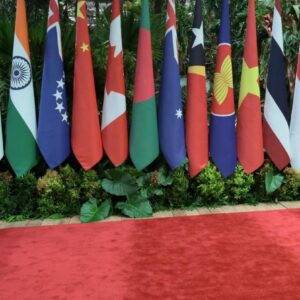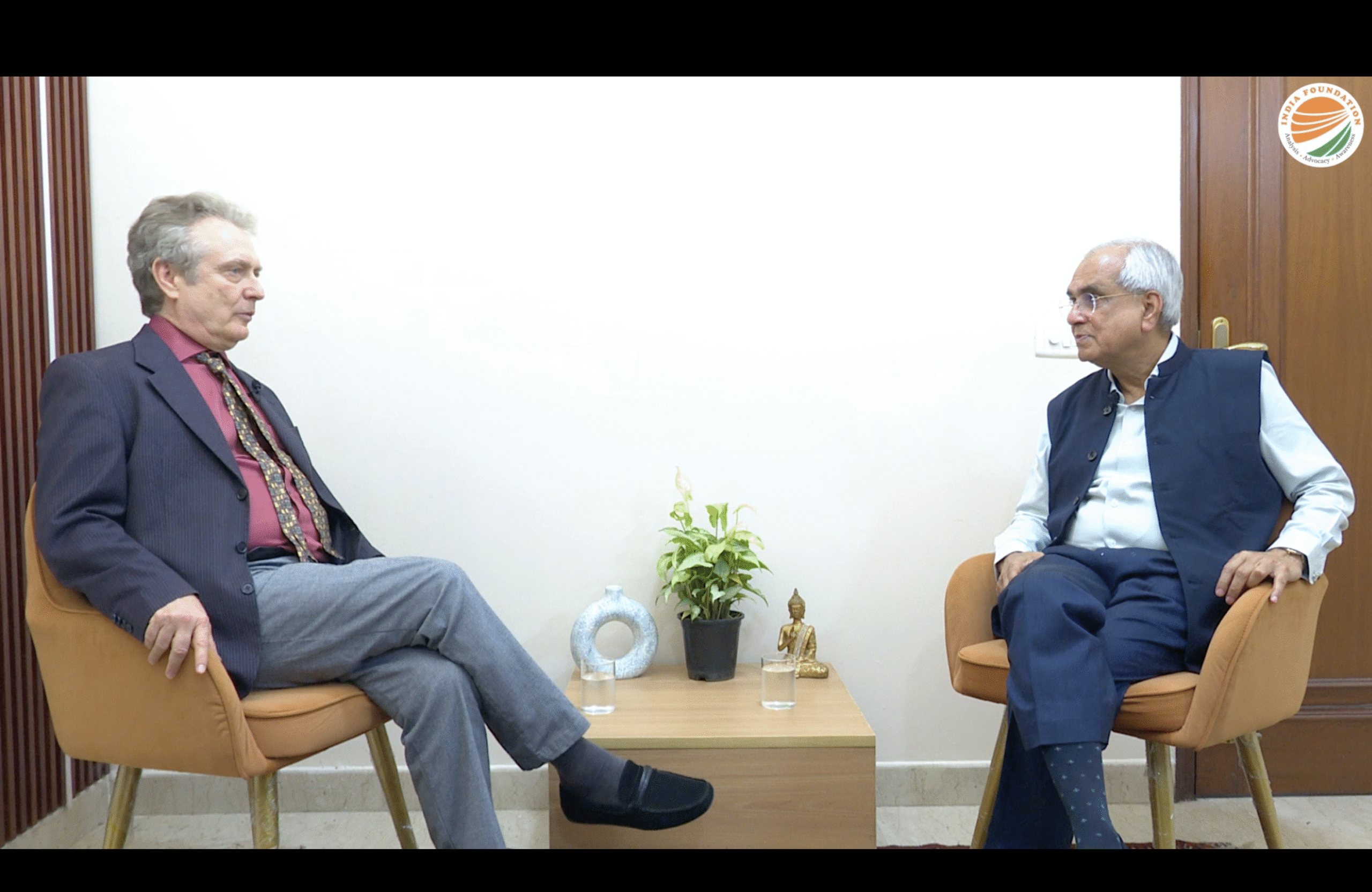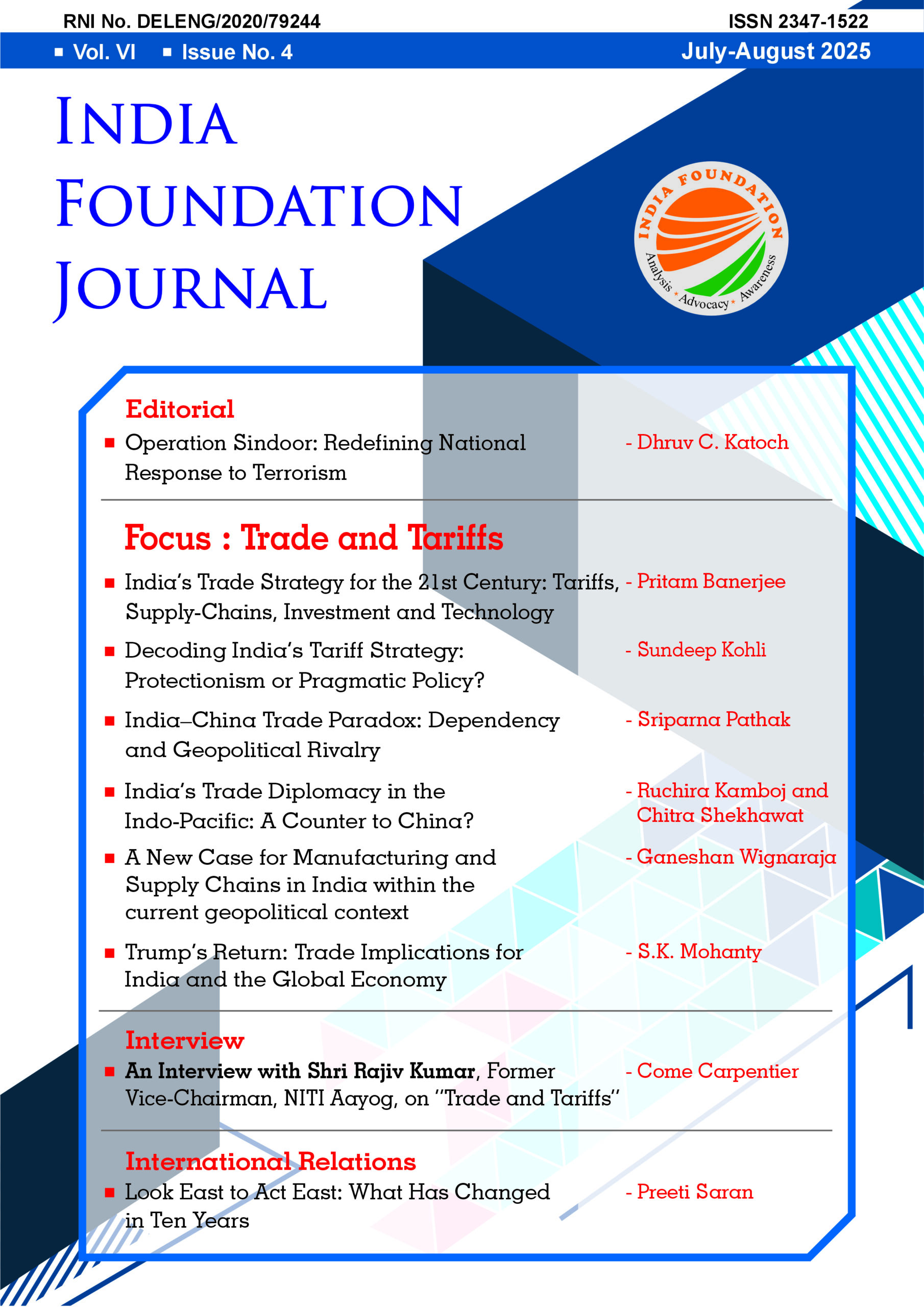Gaurie Dwivedi
Thank you, Mr. Yadav for speaking to India Foundation. The talking point across the world is about the COP 26 milestones, the decisions that have been taken, and more importantly, the parallel narrative that is being built about how India pulled down a collective effort. How do you first view the larger effort that is currently on and then we can get onto the nitty-gritty of India’s position?
Shri Bhupender Yadav
A major milestone for the United Nations Framework Convention on Climate Change (UNFCCC) negotiations was the Paris Agreement in 2015. In principle, it was accepted by almost all the nations across the globe. There were two basic spirits of the Paris Agreement. First is Common But Differentiated Responsibilities (CBDR) and the second is climate finance. Due to the increasing global warming, every nation was concerned and had concurring opinion that solutions needed to be implemented for its mitigation and adaptation. For the question about ‘how’ to implement these solutions, the answer was ‘Common but Differentiated Responsibility”. We all have the same target, that the world should be saved from climate change, but every nation would have to take decisions based on their national circumstances. That is why even the targets set in the Nationally Determined Contributions (NDCs) were based on individual national circumstances of different countries. Second, the major countries, the ones who captured maximum carbon space during the industrial development, committed that they would give compensation and climate finance for these contributions. This is why, when this discussion came up in Glasgow, it was asserted that as per ‘CBDR,’ each country has the right to take decisions about energy production. A fundamental of ‘Climate Justice’ is also poverty eradication. In fact, India is one of those countries who impose maximum tax on fossil fuels. Our petrol and diesel tax is among the highest. On the other hand, we provide ‘Ujjwala’ subsidies to 12 crore women. This way, the smoke that would be created in their rooms due to biofuel combustion is decreased. This has brought change in the lives of 12 crore women. For this reason, our point was, and not just us but all the BASIC countries (Brazil, South Africa, India and China)—and even other developing countries had this common point—that the principle of CBDR be accepted. Common but differentiated responsibility according to national circumstances and subsidy will be continued, subject to the poverty eradication and vulnerability of the local society. We only presented this principle, the voice of the developing countries in front of the world.
Gaurie Dwivedi
When I said that a narrative is being built, it has to be seen that India’s per capita emission is just one-seventh or one-eighth of the US and is also even lower than China’s. Considering how big a polluter China is, they must take bigger steps. But, when the negotiation was on in COP 26, India was connected to these countries, considered alongside China, which somehow undermines our efforts. How do you view the situation?
Shri Bhupender Yadav
India is among those countries who achieved the NDCs they declared in Paris. And not just achieved, we also fixed ambitious targets. In our renewable energy production, we reached 165 GW. We now took a target of 500 GW. Even before that we targeted 450 GW. We said that we will take our renewable capacity to 40%, and we achieved that goal and now we are moving to 50%. We said that we will reduce carbon emissions and we did reduce them. The biggest point is that under our Honourable PM, Shri Narendra Modi Ji’s Panchamrit, India presented a new action-oriented example to the world. We will cut our carbon emissions due to development by 1 billion tonnes by 2030. It is a cumulative effect and is being done very scientifically. We believe in action along with vision. After 2015 Paris Agreement, India joined three major action programmes with regard to climate change. First, we started International Solar Alliance with France. Today, 102 nations of the world are members of the Solar Alliance. This significant achievement happened in Glasgow, and is not limited to International Solar Alliance alone. We are now moving towards ‘One Sun, One Grid, One World’. Countries like France, UK, Australia, US and others have come forward for this. Second, we are working on how to promote green technology in sectors which are major carbon emitters like cement, aluminium and others. Corporates and various countries are coming together to deliberate on this issue, on the platform of Lead IT that we have created along with Sweden for this purpose. Third, India has also been doing great work on the Disaster Resilient Infrastructure platform that we have with UK. This time our honourable PM came together with the PM of Australia and the PM of UK to create the IRIS platform to help small island nations with their vulnerabilities. This once again shows both our vision and action.
Gaurie Dwivedi
According to you, what are the major steps that India needs to take in the next five to eight years and what are the steps for which the world needs to put in collaborative effort?
Shri Bhupender Yadav
One crucial issue is the target of Panchamrit that our honourable PM Modi ji has shown. Second is technological development. How do we move towards green energy? We are working on increasing our solar energy generation capacity and alongside have also initiated a National Hydrogen Mission. We also have to look into changing and adapting our lifestyle practices. Simultaneously, we also have to increase the global carbon sink. I believe that the developed countries, who not only have a moral responsibility but also a pledge, should come forward for technology transfer and climate finance. They must accept their large amounts of carbon emissions and historical wrongdoings that they have committed. In this matter, India fervently leads all the developing countries.
Gaurie Dwivedi
If developed countries need to move ahead in this direction, there needs to be a realisation that 2009 level of fundings cannot be expected in 2021 or 2030. In this regard, how are the developed countries being pushed to fulfil their responsibilities in terms of funding?
Shri Bhupender Yadav
India has been exerting a great deal of pressure on this issue. You earlier talked about making collective efforts. Our honourable PM gave the mantra of ‘environment-friendly lifestyle’. If this time, there were six or seven decisions taken in this direction, it was because of India’s strong representation of the voices of developing countries. Firstly, in Glasgow, all developed countries expressed deep regret that they couldn’t provide climate finance. Now they would have to do more for this responsibility. Besides expressing deep regrets, they also need to take action. Second, an ad-hoc committee was discussed for deliberating the definition of climate finance. Discussion also took place over continuation of long-term finance. A draft would also be prepared about adaptation, between the time-frames from Glasgow to Sharm el-Sheikh. Most importantly, we have always held that if they do not carry forward the CDM (Clean Development Mechanism) and the CERs (Certified Emission Reductions) from the Kyoto protocol, then there would be no credibility to the issue of carbon credits that they wish to raise. We believe that this issue raised by India and other developing countries has been fully accepted as part of Article 6 of the rule book of Paris Agreement. We still hold that developed countries should come forward to fulfil their responsibilities.
Gaurie Dwivedi
Recently, Germany announced a funding commitment of 1.2 billion Euros for India to fight climate change. Do you believe that issue of environment leadership that India has been raising would give an impetus to increase funding and solve this problem of funding?
Shri Bhupender Yadav
With regard to funding, I believe that there needs to be more clarity on climate finance. This must happen with pace. As far as India’s initiatives are concerned, India has not only set ambitious targets, but has also fulfilled them. One of the major threats of climate change is desertification of land; to address that we are running a joint-programme of eight ministries. We are undertaking major projects such as NCAP to solve the problem of air pollution. Over ten of our ministries are working on various initiatives with regard to environment including Swachh Bharat mission, Ujjwala Yojana, Unnati project etc, as well as work in the agriculture sector. All those techniques, adaptation practices and mitigation measures that are needed to be taken by modern societies are being implemented by India.
Gaurie Dwivedi
Do we need to change our perspective about environment? We need to be careful, conscious and aware that when we talk about environment or climate, it is one of the foremost threats to the world at large. Do you think that this larger transformation has not happened by now? It is an ongoing process and would not happen in a day but do you think that there should be more work in this direction by the civil society, academia, research and other?
Shri Bhupender Yadav
This is a fact that environment awareness needs to come and environment education has to be pushed. Climate Justice also needs to be brought to the fore. The issue of lifestyle should also be raised. We have 17% population of the world but account for just 4% of total carbon emissions. Hence, our per capita emissions are very low. There is also an issue of lifestyle, which must be discussed. Our honourable PM has also focused on this issue. Besides lifestyle changes, we also need to put impetus on our biodiversity, flora, fauna and our other issues. The world needs to rapidly progress in adoption of green technology, which is environment-friendly, through technology transfer. Meanwhile, nations must also fulfil their responsibilities towards their citizens. This is such a balancing act in which all nations need to work together, because the impact of climate change transcends geographical boundaries and has a cumulative global effect. That is why every country must contribute, based on their national circumstances. India strongly believes in these thoughts and regularly asserts them. Climate Justice is an important part of Climate Change. Eradication of poverty is a crucial part of Climate Justice. That is why every country must take this into account while going forward.
Gaurie Dwivedi
There is a great deal of concern that technology transfer is not taking place. What do you think should be the roadmap ahead? Should it include public-private partnerships, or B2B or remain only in government-government (G2G) sector?
Shri Bhupender Yadav
This should be open and include all forms and modes. The way we are digitally empowered across the world, knowledge-sharing, transfer and knowledge base are fundamental but what is important is that we become more open, responsible and poor-friendly towards knowledge sharing.
Gaurie Dwivedi
Would the government focus more on the idea of green-hubs or do you believe that this can be just one aspect of the solution while a holistic solution needs to be 360 degrees?
Shri Bhupender Yadav
We need a 360-degree solution. Green sink must rise but along with that we also need to look at desertification of land, problems in coastal areas, adoption of new agricultural practices, threats from rising emissions from new cities and other critical aspects. Our earth is under a layer of gases and rising emissions of CO2 and other gases is having a significant impact on the same. Even in this regard, nations need to take action considering their national circumstances. Just few months back, India’s Cabinet also approved the Kigali amendment which talks about phasing down of these hydrofluorocarbons. Such decisions are being taken across the globe, but what is necessary is that it involves capacity building of all countries. This is why, when the issue of loss and damages, time-framework and measurement methods was raised in Glasgow, India put forward the point that developing countries should be equipped with both capacity and finance and this was agreed to. I believe that if our framework to gauge global warming is strengthened, the world would be better able to face the upcoming threats in a collective manner.
Gaurie Dwivedi
When we talk about India in the context of climate and environment, a major issue that comes up is of air pollution. Now it has passed the phase of challenge and evolved to become an emergency. What kind of measures do you think need to be taken? How much do you envisage the role of states and the federal structure? Is there going to be a holistic solution to it or will people continue to suffer?
Shri Bhupender Yadav
Indeed, there are solutions. You have asked an important question. I wish to point out that air pollution and climate change are two different aspects. But since you have asked this question in the context of India, I will answer. The 15th Finance Commission has announced a Rs 4,400 crore package that we have also started distributing to states. Our honourable PM has also started National Clean Air Mission Programme and we have started regional meetings for it as well. Recently, we had the first meeting in Mumbai and we are going to conduct more meetings across the country. We have selected 138 cities which are reeling with air pollution. We have signed MOUs with their municipalities and released certain guidelines for them which covers issues including garbage combustion, vehicular pollution, dust pollution, thermal power plant mitigations, industrial pollutions. We have chalked out plans for these issues and even worked out a method for measurement.
Second, under environment ministry we have also released the ‘Prana portal’ for public awareness on the issue. Indian government has also brought a Special Act for Delhi-NCR region. For the first time, we have given legal recognition to air sheds. To manage Delhi’s pollution, we moved from BS-IV to BS-VI petrol and nationally, we have introduced a scrapping policy. In Delhi, we have diverted traffic to eastern peripheral expressway and western expressway and brought policy to measure dust pollution. We are shifting the entire industry to PNG to reduce industrial pollution. In a few days, our National Air Quality Control Authority, which has technicians and experts, is going to bring forth a mega programme to solve the pollution of Delhi-NCR region. We have also introduced few new ways to deal with stubble burning to reduce its pollution. First, we have distributed machines to end the stubble. Nearly Rs 700 crore have been expended by the Central Government for the same. Second, the government worked, both independently as well as in collaboration with various groups, on decomposition of the stubble to convert it to manure. This was done on nearly 1 lakh acre land in both Punjab and Haryana and about 6 lakh acre land in Uttar Pradesh. Thirdly, we also worked on utilising it as biofuel. Nearly 1,500 tons was acquired by NTPC, which was a pretty big tender. To utilise it as animal fodder in future, a small pilot project was run to dispatch it to Kutch and Western Rajasthan, where there are cattle in large numbers but lack of fodder. Even though it was at a small scale, the pilot project did take place. In COP 26, one Indian youth got award for Takachar, a firm that works on converting stubble to product while in the cutting phase itself, and then directly sending it for biofuel. In future, there would be more such experiments. Comprehensively, we nudged and appealed to the farmers to not simply burn the stubble but to rather utilise it to increase their production and incomes or use it as manure. In light of the four-five new initiatives, I believe we would be better able to handle the problem in future.
Gaurie Dwivedi
My last question: As 2021 draws to a close, what would be the two-three defining initiatives by your ministry in the post-COP26 world, in 2022, in light of all the developments of this year?
Shri Bhupender Yadav
Our Ministry has brought forth changes in two Acts which have been forwarded to various committees of the Parliament. First, we are providing approval to the CITES (Convention on International Trade in Endangered Species of Wild Fauna and Flora) Treaty in the Wildlife Act, to uphold the international standards of wildlife protection in our country. Second, biodiversity is one such field that can help our farmers and tribals to prosper through the rich flora of our country. We are working on increasing their productivity through innovation and academic research of international standard. Third, there are a lot of lakes in our country. We are targeting to get Ramsar Convention status to 75 lakes. As of now, we have been successful in getting 47 lakes registered. Ten of our beaches have got blue tag and we plan on working more for their conservation. Similarly, we are looking into the issue of Western Ghats. We also aim to push forward our National Clean Air Programme with more sincerity. We have great institutions in our country like Biological Survey of India and Zoological Survey of India, which efficiently raise the issues of flora and fauna, and we plan on strengthening such institutions. 14 of our tiger reserves have got accreditation so we aim to work with more rigour in this direction. To make our environment clearances more nature friendly and development based, we are also working to improve our Parivesh portal. I believe that with these targets we would be able to protect our biodiversity, lead to more afforestation, and push forward an environment-friendly development in the country.
Brief Bio:
*Shri Bhupender Yadav is Union Minister for Environment, Forest and Climate Change and Labour and Employment, Government of India.
*Ms Gaurie Dwivedi is a Journalist and Author.




